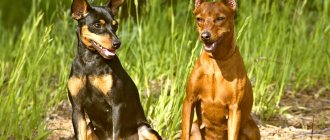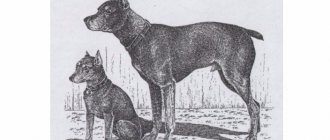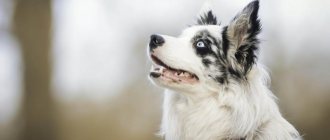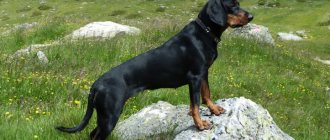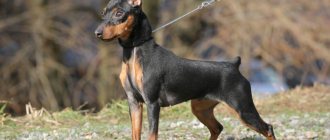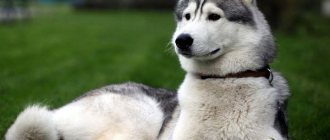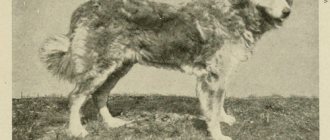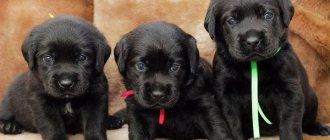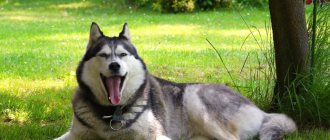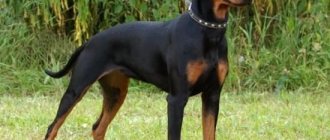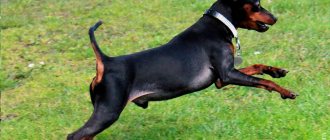- Dogs
- Dog breeds: all dogs from…✔
- Austrian Pinscher (Austrian Shorthaired Pinscher)
Austrian Pinscher ( Österreichischer Pinscher
) or the Austrian Shorthaired Pinscher
is a stocky, medium-sized breed of dog, bred in Austria, originally as a herding dog, and later as a rat catcher and guard dog.
Now it is a hardy peasant dog, a companion dog. Previously, the Austrian Pinscher and the Austrian Shorthaired Pinscher were two different breeds, but are now combined into one. At a certain time, this breed was very neglected and no attention was paid to its development, so the appearance of the Austrian Pinschers is varied. The breed is not very common outside of Austria. The Austrian Pinscher has very expressive eyes and a lively look. “I was bitten by an Austrian pinscher yesterday, for no reason at all!” - He was probably mad? - No! Am I a fool to pull a mad dog by the tail!
History of the origin of the breed
At the beginning of the 20th century, the Austrian dog handler Emil Hauck, while traveling around the country, became acquainted with village pinscher-type dogs, which interested him greatly. He began to work for their recognition as a separate breed, which he described as the Landpinscher. This is what prompted him to do this, as he himself wrote:
“...For four thousand years in the territory of ancient Austria, especially in Lower Austria, there has been a breed of dog that has survived without any artificial selection or outside intervention. However, in recent decades, on the one hand, it has been supplanted by the fashion for other dogs, especially shepherd dogs, and on the other hand, its appearance and essence have been changed due to the unintentional admixture of foreign blood.
Since 1921, we have done everything possible to prevent the destruction of this type of dog - a brave home guard, ancient and indigenous, unpretentious, hardy.
In 1929, when the first targeted breeding was already successful, the breed was recognized.
From a historical point of view, the Austrian Shorthaired Pinscher is descended from the Stone Age Canis palustris (peat dog), the remains of which have been found in the pile buildings of Lake Mondsee, Lake Attersee and the Ljubljana marshes, as well as in several other Neolithic and Bronze Age sites.
Also, the skulls found in recent years have confirmed the absolute coincidence of forms, which confirms the relationship of our pinscher with these ancestors. Widespread in ancient times in central Europe, the turf dog is the ancestor of a large number of modern breed groups, such as pinschers, schnauzers, spitzes and terriers.
The height at the withers of the Austrian Shorthaired Pinscher should be approximately 40-45 cm and never exceed 50 cm. The dog should remain small and compact. Food scraps from the farmer's table should be his food. Its small size also makes it less dangerous to wild animals and allows it to be kept in a kennel (with plenty of room to move) or in a stable without having to constantly chain it up.
- Our Pinscher, in fact, combines everything that one would expect from a domestic dog: high alertness, vigilance, courage, loyalty, incorruptibility, undemandingness, resistance to various weather conditions and a pleasant appearance, in no way distorted by the demands of sport or fashion" (Dr. Emil Hauck, "The Country Dog", translated from French, published in Pincher magazine 68 (1/2000))
As mentioned above, since 1921, planned breeding began to be supported by the national kennel club. The first official representatives were shown at exhibitions and entered into a special register. In 1927, a general standard was developed, and on October 16, 1928, the Landpinscher was recognized by the Austrian Cynological Association (AKA) as the "Austrian Shorthaired Pinscher."
- After 1929, the “Association for the Promotion of Purebred Breeding of Austrians” was founded and active breeding began.
The Second World War left its mark all over the world. At that time, there were only 10 active nurseries in Austria, but from 1948 to 1954 only 55 puppies were registered. Particularly difficult times began in 1954. Only 43 puppies were born in the next 18 years. In the 1970s, there was only one purebred “Austrian” left - a male named Diocles von Angern. The breed is on the verge of extinction!
But here the story takes a happy turn. The Mangold family with the vom Schildbach kennel took over the breeding of the Austrians, and from 1979 to 1983 four litters were born - 29 puppies. The original animals were the only fertile more or less pedigree dogs remaining at that time: Diocles von Angern and 3 Landpinschers (Tersia von Achren, Tyrol; Prima Nora, Lower Austria and Buffi, Hungary).
Gradually, breeders became interested in the Austrian both at home and abroad. Breeding animals were exported to Holland and Denmark, where they were crossed with breeds such as Entlebucher Mountain Dog, Miniature Pinscher and German Pinscher. The offspring from these matings returned to Austria and formed two breeding lines.
- On the one hand, some breeders sought to make him famous at shows by quickly standardizing his appearance, which led to a rapid increase in inbreeding in this now closed population.
- On the other hand, some breeders pursued the goal of preserving the original characteristics of the Austrians, such as physical endurance and guarding qualities. In the 1980s, the club attempted to regulate breeding, but this was unsuccessful.
Only in 2002 was the first “Austrian Pinscher Club - KOP” founded, and breed selection criteria were created, which set the ultimate goal not only to standardize appearance. The rules of minimizing inbreeding and increasing genetic diversity have become widely accepted by breeders over the past few years, although the two main goals, namely success in shows and maintaining the characteristics of farm dogs, are often not pursued to the same extent.
Another “desirable profile” in breeding has also been created: a sporting dog that can successfully compete in agility and other canine events.
Austrian Pinscher
Modern Austrian Pinschers trace their ancestry to the ancient breed of Austrian Pinscher, which was widespread in the second half of the 19th century and was used in rural areas on farms.
In 1921, work began on the systematic breeding of this breed. On October 16, 1928, the breed was recognized by the Austrian Kennel Club, and in 2000 its name was changed - the word “shorthair” was excluded.
The character of Austrian Pinschers is flexible and modest, friendly, loyal and incorruptible.
Outwardly, they differ from other pinschers, they look stocky and squat:
- Height at withers: from 42 to 50 cm.
- The color is red, tan and brown, with white markings often found.
- Ears are “buttoned” (with a bend, drooping), small in size, set high.
- The bridge of the nose is straight, the head is pear-shaped.
Pinschers are distinguished by their loyalty and strength. Dogs of this breed group will settle well both in a family and with a single person
But no matter how smart the dog is, it needs to be raised properly and given due attention, including care and maintenance
Additionally, check out a short video about the Miniature Pinscher dog breed:
The breed today
Today it is about achieving these different goals "under one hat" and carrying out a breeding program that takes into account both the genetic criteria of the population that maintain or improve the health of the breed, as well as the preservation of basic characteristics adapted to today's times, and then taking into account the phenotype (external species). A difficult task that needs the support of all Austrian lovers.
At the moment, there are 3 ongoing projects aimed at developing the breed:
- The main project is the “Landpinscher Project”, which aims to genetically diversify the population through the influx of blood from suitable individuals. The Landpinscher is a dog that matches the personality and appearance of the Austrian, but is of unknown origin. Animals that match the traits are entered into a registry, undergo a health check, are described at exhibitions, and then enter a breeding program.
- The second project is “Austrian Pinscher for Austrian backyards”, the goal of which is to promote breeding on farms, since the conditions of the farms correspond to their original purpose.
- The latter is a lengthy thesis by Katharina Wetzstein of the Veterinary Faculty of the University of Vienna, which concerns the health of Austrians.
History of the breed
There is no clear evidence, but it is possible that the Austrian Pinscher is a direct relative of the German Pinscher. This fact is supported by the similarity in appearance and the close proximity of the habitat regions.
It has been proven that this breed was bred to guard farmland and hunt small animals . The close proximity of forests suggested invasions of rodents (rats, gophers), hares and foxes. Pests damaged farm crops and crops. Austrian pinschers coped well with this problem.
General characteristics, description
The Shorthaired Pinscher is a compact, medium-sized dog, 42-50 cm high, with short, dense coat that is resistant to various weather conditions.
- The shape of the head is pear-shaped and has significant differences between females and males. The ears are small, hanging or semi-dropping, set high.
- The tail is crescent-shaped or curled into a single ring. The color is varied: fawn, various shades of red, black and tan. White markings on the head, chest and feet are often present and are not considered a fault.
The current FCI standard dates back to 2003. The most significant difference compared to the old FCI standard is the change in name: from “Austrian Shorthaired Pinscher” to “Austrian Pinscher”.
Other changes include raising the minimum height from 35cm to 42cm and recognizing black and tan as the standard coat.
- For unexplained reasons, unfortunately, the liver and black colors, which have always been recognized and widespread, were excluded. It should be noted that black dogs are still born regularly today.
There is no single phenotype in the breed yet; individuals often look different. But it must be remembered that the breed is still in its formation stage.
Character
To understand the main character traits of the Austrian, you should pay attention to the original purpose of its use by farmers.
As a universal yard dog, he was expected to warn with a loud bark about the appearance of strangers in the territory, destroy rodents in the yard and house, help in driving livestock and not have a tendency to wander, that is, to be attached to his family and the possessions entrusted to him .
As in the old days, the Austrian or Shorthaired Pinscher today remains a good guard dog, he is distrustful of strangers, but at the same time he is very connected with his family, good with children and pets.
Care and maintenance
It does not require any special conditions; it is a very versatile and unpretentious dog. He will be equally happy both in an enclosure or a booth on the street, and in a house on a soft sofa next to his owners, the main thing is to provide the opportunity for active walks.
All grooming procedures consist of periodic combing of the coat, hygienic cleaning of ears and teeth, and trimming of nails.
Veterinary procedures are limited to periodic general examination, deworming and vaccination.
Nutrition
In terms of feeding, Austrian Pinschers are quite unpretentious. They eat meat and offal and do not give up vegetables and cereals.
A good food option would be boiled porridge made from crushed cereals with the addition of meat.
You should not overfeed your Pinscher if you cannot provide him with sufficient physical activity. Make sure your dog doesn't overeat. And this option is quite possible, because pinschers love to eat tasty food, and can beg from the owner for various goodies in addition to lunch.
Training and education
He is absolutely suitable even for a novice dog owner due to his good-natured disposition. He can be a little stubborn, but never shows aggression towards members of his family, so there are usually no problems with training.
If an Austrian has some kind of “business”, he does not require any special education. With these dogs you can enjoy agility, obedience, trick training and even search and rescue service.
Austrian Pinscher
“Bite” is how the word “pinscher” is translated, so a dog of this breed, while protecting its owner from attacks, can attack not only animals, but also humans. The Association for the Conservation of Endangered Indigenous Breeds, Ark Austria (Arche Austria), has listed the Austrian Pinscher breed and stated that it is very vulnerable, as only 6 to 12 animals have been bred, which are carefully bred to preserve health and breed appearance. Such qualities of the animal as endurance, activity, and strong character are the distinctive features of this interesting breed.
The main ancestor of the Austrian Pinscher (which is also called the Austrian Terrier) is the German Pinscher. The animal was mainly used to guard the farm or to hunt foxes and hares, but it was certainly never a dog for “household use.” Despite its “rural” background, the dog is very polite and smart, and is easy to train. The Austrian Pinscher is cheerful, fearless, hardy, playful, active, “silent”, and an excellent watchman.
The breed has a variety of colors - yellow, golden brown, beige, reddish brown, black, black and tan, brindle, almost always with large white spots on the neck, chest, limbs and head. The head of the Austrian Pinscher is pear-shaped, wide skull. The transition from forehead to muzzle is well defined. The nose is dark, the muzzle is short. Lips fit tightly. The Austrian Pinscher is a fairly powerful and stocky dog with a large neck. The pinscher's tail is set high and is often curled into a ring on the back.
Austrian Pinschers are distinguished by their intelligence and liveliness. These dogs are very loyal to close people, but at the same time quite distrustful when it comes to strangers, since they are still guard dogs. The best traits of a pet appear when living in rural areas. An Austrian Pinscher can feel good in an apartment only if it is properly raised in early childhood. Familiarity is not for Austrian Pinschers; they get along well with children, but they still don’t allow themselves to be pulled by their ears and tail; they may even bite
The Austrian Pinscher is very affectionate, cheerful and playful with close people, but if one of the strangers appears on the way, the Pinscher begins to bark loudly and attract attention, this is quite inconvenient when it comes to keeping it in an apartment. Of course, this wonderful dog will prefer life outside the city, where they feel comfortable
The breed has fairly good and good health and strong immunity. The Austrian Pinscher may suffer from heart problems - this is an inherited breed trait.
Therefore, you need to pay attention to timely inspection by a qualified specialist. Today, this excellent guard dog is bred in Austria, Germany and with varying success in Denmark, because many people have lost interest in these loyal, cute creatures.
In 2003, there were only 600 pedigree dogs worldwide.
The coat of this dog does not require any special special care. It is enough to brush your dog once a week with a special brush. The Austrian Pinscher is an excellent guard dog, ready to raise the alarm at the slightest suspicion, capable of fearlessly attacking a criminal and remaining vigilant all night. However, when hunting, dogs of this breed exhibit terrier habits: they dig holes, chase foxes and hares. Therefore, this mobile and surprised active animal requires large spaces. The Austrian Pinscher is more suitable for living outside the city.
You need to patiently and consistently raise your Pinscher from the first weeks of life. The dog needs frequent walks with significant physical activity. For sporty people and those who like to travel, this dog will be ideal. It is also indispensable in hunting fox and hare. It's easier to teach if you don't punish too much. For an Austrian, the “carrot and stick” method is not suitable, only encouragement, praise and play. The animal's favorite toys are balls. The Austrian is very stubborn and if you use force, you are unlikely to get a return from him, but in the game he can willingly become “the hero of your novel.”
Health and life expectancy
For the most part, this is a very healthy and problem-free breed. Most often, owners turn to the veterinarian only for regular vaccinations and examinations. And this is easily explained - a constantly ill or weak dog could not fully perform its service, and more often than not it simply died, leaving no offspring, that is, only healthy, strong individuals reproduced successfully.
But given the current situation in the population, where the number of closely related crosses is very large, certain pathologies are still recorded (very rarely).
The University of Vienna is currently working on a study of the hereditary health of the Austrian representative.
- Several diseases are already known that are believed to have a genetic basis, for example: luxating patella; dysplasia of the elbows and hip joints; cardiovascular diseases such as pulmonary or aortic stenosis; epilepsy. These diseases can usually only be found in adult animals.
- Others: cryptorchidism, congenital deformities of the limbs, dental defects, persistent pupillary membrane, etc. – these diseases or developmental pathologies are recognized already in puppyhood. Tumors also occur, sometimes even in young dogs, and a genetic basis can also be suggested here.
According to a statistical sample from 2002-2008 from all over Europe, the average life expectancy for them is about 10 years. 25% of the dogs that died were under 9.5 years of age, but 25% were over 13.5 years of age.
Possible diseases of the Australian Shorthaired Pinscher
Due to the high appetite and great love for goodies, the Pinscher may develop obesity. In order to avoid obesity, the owner should not follow the cunning lead and devote more time to the physical development of his pet. A balanced diet and active exercise will help prevent and treat obesity.
It has been proven that Austrian Pinschers are prone to diseases of the cardiovascular system, so it is worth periodically paying attention to the well-being of your pet and, at the slightest deviation, contact a veterinarian or dog handler.
The price for an Austrian pinscher varies from 10 thousand to 20 thousand rubles , depending on the pedigree and health status.
Reviews
Marina (Durnstein, Austria):
“My husband is an ardent fan of the Austrians. For my mother and I, who are accustomed to seeing such dogs in Russia as mongrels (we ourselves have kept miniature schnauzers all our lives), this passion was incomprehensible at first. But after getting to know different representatives of the breed better, my opinion changed. The dogs are small, friendly, get along well with each other, and are very sociable. As a family dog - a very suitable option. I know little about their working qualities; the breed is in the recovery stage. I know that it’s not that difficult to find them on private property or on farms, which means they are in demand among the local population.”
Share link:
